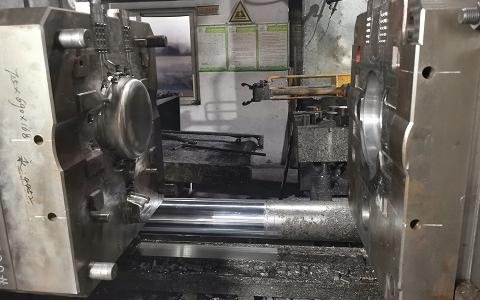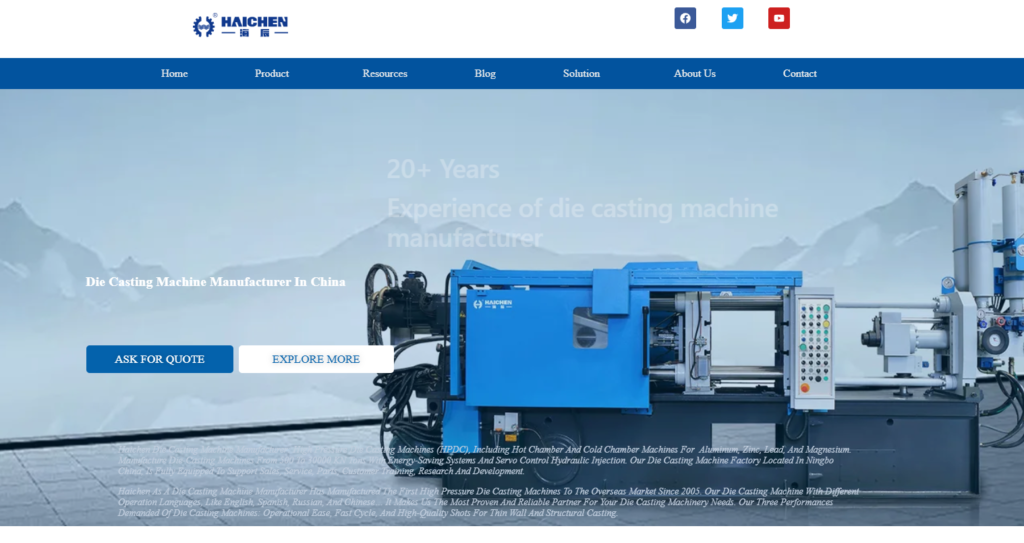Pressure die casting is an advanced metal casting process that is widely used to produce metal parts with high precision, high strength and high surface finish.
Die casting mould preparation
Before starting high-pressure die casting, the mold needs to be prepared first.
This step involves cleaning the mold and spraying its inner walls with lubricant.
The role of the lubricant is to control the temperature of the mold and form a thin film between the molten metal and the mold to facilitate the subsequent release of the casting.

Pressure die casting Injection
After the mold is ready, the molten metal is injected into the mold cavity.
Depending on the type of material used, a hot or cold chamber injection system can be selected.
Hot chamber systems are suitable for low-melting metals such as zinc and magnesium.
While cold chamber systems are used for high-melting metals such as aluminum and brass.
During the injection process, the metal quickly fills the mold cavity under high pressure, ensuring that the mold is completely filled and avoiding defects.

Cooling and solidification
After the metal is injected into the mold, it quickly cools and solidifies into shape.
The cooling rate is critical to avoid defects such as porosity, cracks, or deformation.
During the solidification process, the mold remains closed to ensure that the metal can be evenly solidified.

Demoulding and dressing
When the casting is completely solidified, the mold is opened and the ejector rod is used to push the casting out of the mold.
This is followed by trimming to remove excess material such as gates, risers, and flashes to obtain the final shape.
How to monitor and ensure the quality of castings in the process of pressure die casting?
- Mould Inspection & Maintenance
- Parameter setting and real-time monitoring
- On-line inspection and automated quality control system
- On-site inspection and non-destructive testing
- Raw material selection and handling
- Operation & Maintenance
- First Article Inspection vs. Intermediate Inspection
- Dimensional Measurement & Visual Inspection
Mould Inspection & Maintenance
Mold is a key factor that affects the size and surface quality of a casting.
Before the die casting process begins, the mold should be rigorously inspected and tested to ensure that the mold dimensional accuracy and surface finish meet the requirements.
The wear or damage of any mold can directly affect the quality of the casting.
So regular maintenance and upkeep of the mold is also crucial.

Parameter setting and real-time monitoring
Proper parameter setting is the key to ensuring the stability and consistency of the die casting process.
Before the operation of the die-casting machine, it is necessary to reasonably set the processing parameters.
According to the requirements of the product and the characteristics of the process, including injection speed, injection pressure, injection rate, injection temperature, etc.
By optimizing these parameters, it is possible to ensure that the castings are dimensionally stable and have a good surface quality.
In the die-casting process, the die-casting machine should be monitored in real time, and the pressure, temperature, speed and other data should be recorded.
By monitoring the data, anomalies can be detected in time and machine parameters can be adjusted to maintain the stability and consistency of the die casting process.
On-line inspection and automated quality control system
In modern manufacturing, the adoption of on-line inspection and automated quality control system is the key.
By monitoring the quality of castings in real time.
Process parameters can be discovered and adjusted in time to improve production efficiency and product consistency.
On-site inspection and non-destructive testing
On-site inspection of finished die-casting products is an important part of quality control.
The inspection content should include the size, surface quality, pores and pores of the product to ensure that the product meets the design requirements and customer needs.
Through strict on-site inspection, unqualified products can be found and eliminated in time, and the pass rate of products can be improved.
In addition, using non-destructive testing techniques such as X-ray or ultrasonic.
Defects such as porosity, inclusions or underfilling within the casting can be detected in a timely manner.
Raw material selection and handling
Select high-quality aluminum alloy or other alloy raw materials to ensure that their chemical composition meets the requirements of the standard.
And avoid defects such as poor fluidity or shrinkage porosity caused by raw material problems.
Strict screening and pretreatment of raw materials are carried out to remove impurities and foreign substances in them to ensure the purity of molten metal.
Operation & Maintenance
Regularly maintain and maintain the die casting machine and mold to ensure that it is in good working order and reduce casting defects caused by equipment problems.
Strengthen staff training, improve the skill level and sense of responsibility of operators.
And ensure the stability and reliability of the die casting process.
First Article Inspection vs. Intermediate Inspection
During the production process, the first article of each batch is inspected.
To ensure that the first piece of the product meets the specified quality standards.
Intermediate inspections are carried out regularly to ensure that the quality of the output die castings is stable.
Dimensional Measurement & Visual Inspection
Use measuring tools (e.g., calipers, micrometers, projectors, etc.) to measure the size of the die casting to ensure that the dimensions meet the requirements.
Inspect the appearance of die castings, including surface defects, porosity, cracks, etc.
High pressure die casting features
High Speed
Pressure die casting operates at extremely high pressures (typically 700 to 2500 bar) and fast filling speeds (0.5 to 120 m/s).
Ensuring that the molten metal fills the mold cavity quickly and completely.
Achieving high-quality molding even for thin-walled or complex-shaped parts.
High precision and dimensional stability
Due to high pressure and fast filling, the casting has high dimensional accuracy and surface finish.
Usually up to grade 5~8, which is suitable for mass production.
High productivity
High-pressure die casting enables very fast cycle times, making it ideal for high-volume production.
Strong material adaptability
Suitable for a variety of metals, including aluminum, zinc, magnesium, copper and other alloys.
Especially in the automotive, aerospace and other fields of wide application.
High-pressure die casting from Haichen
Together, these steps form the basic process of high-pressure die casting.
Ensuring the efficient and precise production of high-quality metal parts.




